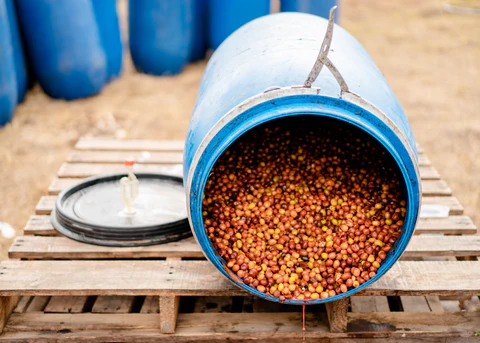The Moka pot, often referred to as a stovetop espresso maker, is a staple in many coffee lovers’ kitchens. Known for its distinctive design and the rich, strong coffee it produces, the Moka pot has been a beloved brewing method since its invention. Central to its functionality is the pressure valve, a small but vital component that ensures both the quality and safety of the coffee-making process.
The Moka Express was invented by Alfonso Bialetti in 1933. This invention revolutionized home coffee brewing by making it possible to create espresso-like coffee without the need for large, expensive machines. The key to its innovation was the use of steam pressure to brew coffee, a process made safe and efficient by the inclusion of a pressure valve.
The pressure valve in Moka Pot plays a crucial role in the operation. By allowing excess steam to escape, it prevents the buildup of dangerous pressure levels within the pot. This not only ensures the safety of the user but also contributes to the optimal extraction of coffee, resulting in a rich and aromatic brew.

How the Moka Pot Works
The Moka pot is a marvel of simplicity and efficiency, composed of three main parts: the bottom chamber, the filter basket, and the upper chamber. Each of these components plays a vital role in the coffee brewing process.
Components of the Moka Pot
- Bottom Chamber: This is where the water is placed. It has a safety valve that ensures any excess pressure can escape.
- Filter Basket: This sits above the bottom chamber and holds the ground coffee. It’s designed to allow water to pass through it and mix with the coffee grounds.
- Upper Chamber: The brewed coffee is collected here. As the water passes through the coffee grounds, it moves up into this chamber, ready to be poured and enjoyed.
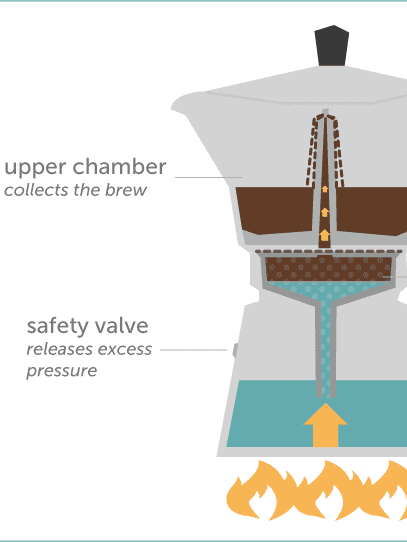
Step-by-Step Brewing Process

- Heating Water to Create Steam:
- Fill the bottom chamber with water up to just below the safety valve. Using hot water can speed up the brewing process and prevent the coffee from developing a metallic taste due to prolonged heating.
- Place the filter basket in the bottom chamber and fill it with medium-fine ground coffee, leveling it off without tamping it down.
- Steam Pressure Pushing Water Through Coffee Grounds:
- Assemble the Moka pot by screwing the upper chamber onto the bottom chamber, ensuring a tight seal.
- Place the Moka pot on a stove over medium heat. As the water heats up, it turns into steam and creates pressure in the bottom chamber.
- This steam pressure forces the hot water up through the coffee grounds in the filter basket. The brewed coffee then rises through the central tube and collects in the upper chamber.
- Importance of Medium Heat and Proper Grind Size:
- Medium Heat: Using medium heat ensures a steady build-up of pressure without causing the water to boil too rapidly, which can lead to a burnt taste.
- Proper Grind Size: The coffee grounds should be medium-fine. If the grind is too fine, it can clog the filter and impede the flow of water, resulting in over-extraction and bitter coffee. If it’s too coarse, the water will pass through too quickly, leading to under-extraction and weak coffee.
The Role of the Pressure Valve
The pressure valve in a Moka pot is a small but essential component that ensures the safe and efficient operation of the coffee maker. Here’s a breakdown of its key roles:
Safety Mechanism to Prevent Excessive Pressure Buildup
The primary function of the pressure valve is to act as a safety feature. As the water in the bottom chamber heats up and turns into steam, it creates pressure. If this pressure becomes too high, it could cause the Moka pot to explode. The pressure valve prevents this by allowing excess steam to escape, thereby regulating the pressure within safe limits. This safety measure ensures that the brewing process can proceed without the risk of the pot bursting due to overpressure.
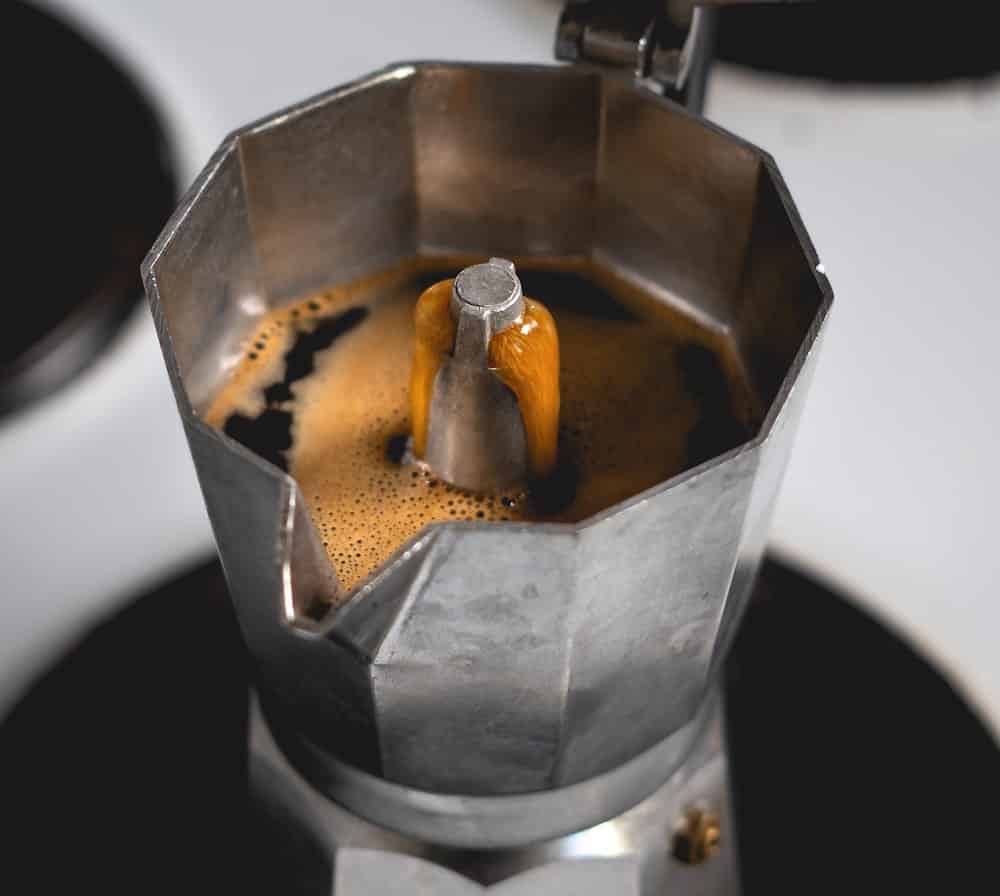
Functionality in Regulating Pressure to Ensure Safe Operation
Beyond its role in preventing dangerous pressure buildup, the valve also helps to maintain the correct pressure needed for brewing coffee. It allows for the steady release of steam, which is crucial for the optimal extraction of flavors from the coffee grounds. By managing the pressure effectively, the valve ensures that the water is pushed through the coffee grounds at the right rate, producing a rich and balanced brew. This regulation of pressure is vital for achieving the desired coffee consistency and taste.

Acting as a Measuring Cup for the Correct Water Level
Interestingly, the pressure valve also serves as a practical guide for filling the Moka pot with the correct amount of water. When filling the bottom chamber, the water should reach just below the valve. This ensures that there is enough water to generate the necessary steam pressure without overfilling, which could block the valve and compromise its function. By using the valve as a marker, users can consistently measure the right amount of water needed for each brew, ensuring consistent coffee quality.
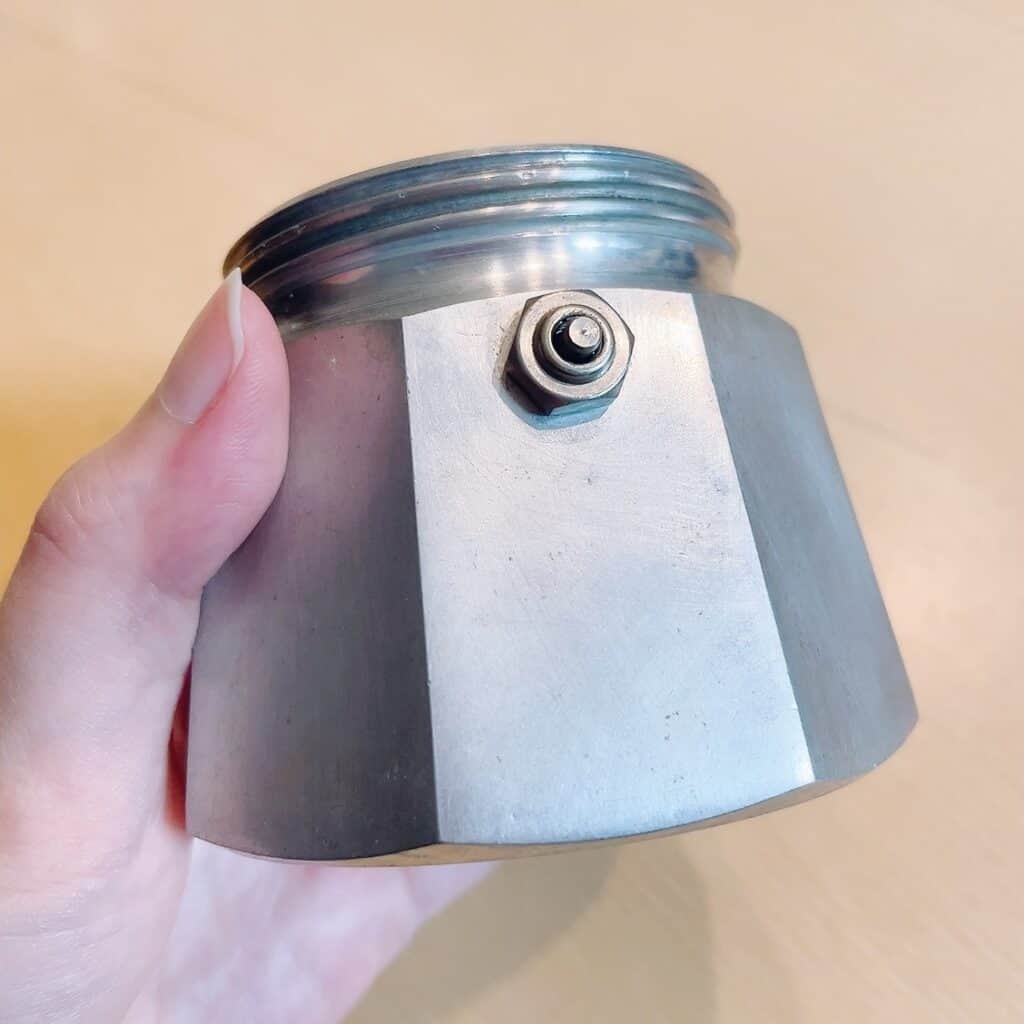
Maintaining the Pressure Valve
Maintaining the pressure valve is crucial for ensuring the longevity and proper function of your Moka pot. Regular maintenance helps prevent limescale buildup and other issues that can affect the coffee-making process.
Importance of Regular Cleaning
Regular cleaning of the pressure valve is essential to prevent limescale and coffee residue buildup, which can clog the valve and impair its function. A clean valve ensures that the pressure inside the Moka pot is regulated correctly, preventing potential safety hazards and maintaining the quality of your coffee.

Tips for Cleaning and Maintaining the Valve
- Using Hot Water and a Brush:
- Disassemble the Moka pot and remove the pressure valve.
- Rinse the valve thoroughly with hot water to dissolve any coffee oils and residues.
- Use a small brush to gently scrub the valve, removing any stubborn deposits. This helps keep the valve’s mechanism clear and functional.
- Checking and Replacing the Gasket Periodically:
- Inspect the rubber gasket that seals the upper and lower chambers of the Moka pot.
- Over time, the gasket can become brittle or cracked, which can lead to leaks and improper pressure buildup.
- Replace the gasket periodically to ensure a tight seal and efficient operation.
- Avoiding Overfilling the Water Chamber:
- Always fill the bottom chamber with water up to just below the pressure valve.
- Overfilling can block the valve, preventing it from releasing excess steam and leading to dangerous pressure levels.
- Use the valve as a guide to avoid overfilling and ensure safe brewing.
Troubleshooting Common Issues
Despite regular maintenance, you may encounter some common issues with your Moka pot. Here’s how to address them:
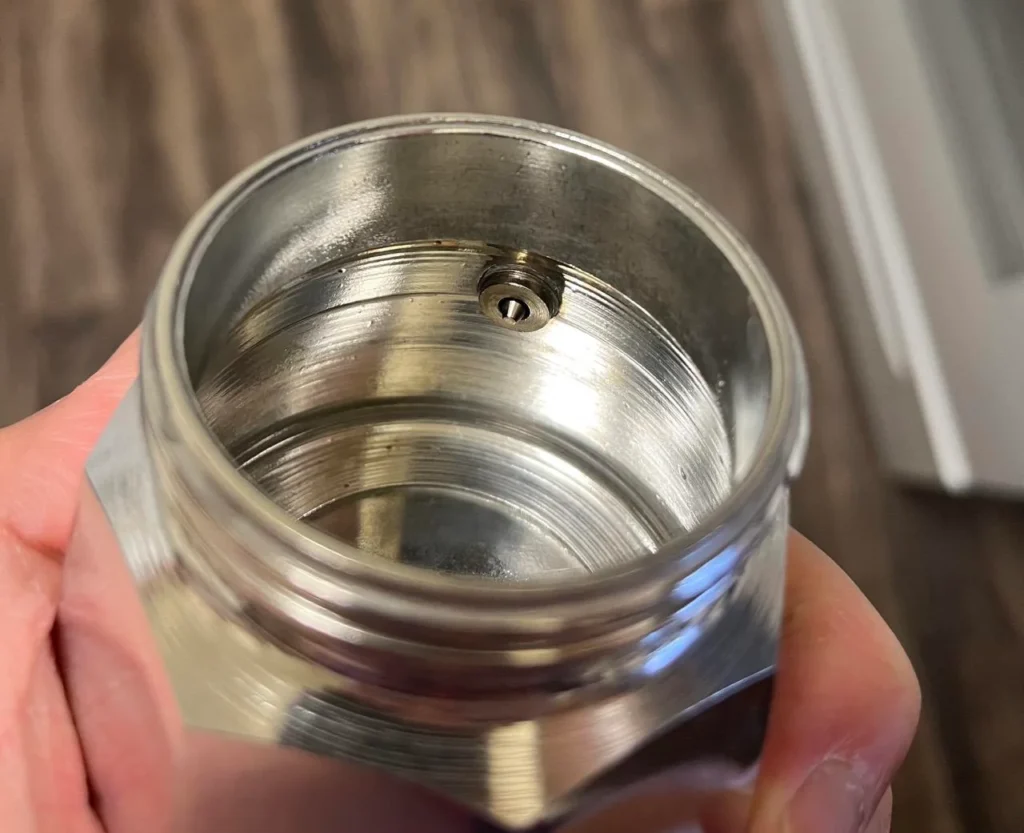
- Ensuring Proper Heat Levels:
- Use medium heat when brewing coffee. Too high a heat can cause the water to boil too quickly, leading to sputtering and over-extraction.
- If the coffee brews too slowly, slightly increase the heat to find the optimal balance.
- Using the Correct Grind Size:
- The coffee grind should be medium-fine. If it’s too fine, it can clog the filter and slow the brewing process, resulting in bitter coffee.
- If the grind is too coarse, the water will pass through too quickly, leading to under-extraction and weak coffee.
- Cleaning the Valve and Other Components Regularly:
- Regularly clean all components of the Moka pot, including the filter, gasket, and valve, to prevent blockages and ensure smooth operation.
- Descale the pot periodically, especially if you live in an area with hard water. Use a mixture of water and vinegar or a descaling solution to remove limescale buildup.
Optimizing Your Brew
To make the most of your Moka pot and consistently brew excellent coffee, here are some key tips and techniques:
Using Filtered Water
Using filtered water instead of tap water can significantly enhance the taste of your coffee. Tap water often contains minerals and impurities that can affect the flavor profile and lead to limescale buildup in your Moka pot. Filtered water helps:
- Improve Flavor: Provides a cleaner, purer taste.
- Prevent Buildup: Reduces limescale deposits that can clog the pressure valve and other components.
Avoiding Over-Extraction by Monitoring Brewing Time and Temperature
Over-extraction occurs when coffee is brewed for too long or at too high a temperature, leading to a bitter and unpleasant flavor. To avoid this:
- Use Medium Heat: Start with medium heat to allow the water to heat gradually. This prevents the coffee from burning and over-extracting.
- Monitor Brewing Time: Pay attention to the brewing process. Once the coffee starts to sputter and you hear a hissing sound, remove the pot from the heat immediately. This indicates that most of the water has passed through the coffee grounds, and continuing to heat can cause over-extraction.
- Avoid Super-Heated Steam: Allowing steam to force through the coffee grounds can scorch them, leading to a burnt taste. Remove the pot from heat just as the coffee finishes brewing.
Adjusting Coffee Grind Size and Water Levels for Desired Strength and Flavor
The grind size of your coffee and the amount of water you use can greatly influence the strength and flavor of your brew:
- Grind Size: Aim for a medium-fine grind. If the grind is too fine, it can clog the filter and cause slow brewing and bitterness. If too coarse, the water will pass through too quickly, resulting in weak coffee.
- Water Level: Fill the bottom chamber with water just below the pressure valve. Overfilling can block the valve, while underfilling can lead to uneven pressure and brewing.
- Experiment: Adjust the grind size and water level to suit your taste preferences. For a stronger coffee, use slightly less water or a finer grind. For a milder brew, use more water or a coarser grind.
Conclusion
The pressure valve is a crucial component of the Moka pot, ensuring both the safety and quality of the coffee brewing process. By regulating the internal pressure, the valve allows for optimal extraction of coffee flavors while preventing dangerous pressure buildup. Additionally, it serves as a practical guide for the correct water level, making it easier to achieve consistent results.
Maintaining the pressure valve through regular cleaning and proper use is essential for preserving the Moka pot’s functionality and safety. By following the outlined tips and techniques for optimizing your brew, you can enjoy rich, aromatic coffee every time.
Embrace the ritual of using the Moka pot, and take care to maintain it well. This will not only enhance your coffee experience but also extend the life of your beloved coffee maker. Happy brewing!
References
- Bialetti on the importance of the Moka valve and its history.
- Espresso Insiders on pressure levels and tips for even extraction.
- NotNotCoffee on preparation steps and brewing tips.
- Above Average Coffee on common Moka pot mistakes and maintenance.
Disclosure: Our blog contains affiliate links to products. We may receive a commission for purchases made through these links. However, this does not impact our reviews and comparisons. We try our best to keep things fair and balanced, in order to help you make the best choice for you.

